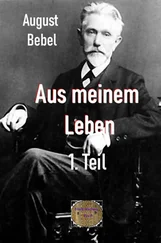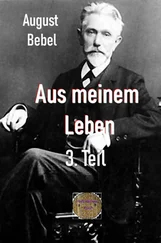August Bebel - Woman under socialism
Здесь есть возможность читать онлайн «August Bebel - Woman under socialism» — ознакомительный отрывок электронной книги совершенно бесплатно, а после прочтения отрывка купить полную версию. В некоторых случаях можно слушать аудио, скачать через торрент в формате fb2 и присутствует краткое содержание. ISBN: , Жанр: foreign_antique, foreign_prose, на английском языке. Описание произведения, (предисловие) а так же отзывы посетителей доступны на портале библиотеки ЛибКат.
- Название:Woman under socialism
- Автор:
- Жанр:
- Год:неизвестен
- ISBN:http://www.gutenberg.org/ebooks/30646
- Рейтинг книги:5 / 5. Голосов: 1
-
Избранное:Добавить в избранное
- Отзывы:
-
Ваша оценка:
- 100
- 1
- 2
- 3
- 4
- 5
Woman under socialism: краткое содержание, описание и аннотация
Предлагаем к чтению аннотацию, описание, краткое содержание или предисловие (зависит от того, что написал сам автор книги «Woman under socialism»). Если вы не нашли необходимую информацию о книге — напишите в комментариях, мы постараемся отыскать её.
Woman under socialism — читать онлайн ознакомительный отрывок
Ниже представлен текст книги, разбитый по страницам. Система сохранения места последней прочитанной страницы, позволяет с удобством читать онлайн бесплатно книгу «Woman under socialism», без необходимости каждый раз заново искать на чём Вы остановились. Поставьте закладку, и сможете в любой момент перейти на страницу, на которой закончили чтение.
Интервал:
Закладка:
This system of relationship is in full force, not only among all the American Indians, as well as among the aborigines of India, the tribes of Dekan and the Gaura tribes of Hindostan, but, according to the investigations that have taken place since Bachofen, similar conditions must have existed everywhere in primitive times, as they still exist to-day among many peoples of Upper and Further Asia, Africa and Australia. When, in connection with these investigations and established facts, the investigation will be everywhere taken up on the sex and family relations of wild and barbarous nations still living, then will the fact transpire that, what Bachofen still confusedly found among numerous peoples of antiquity, and rather surmised than otherwise; what Morgan found among the Iroquois; what Cunow found among the Austral-Negros, are but social and sexual formations, that constitute the groundwork of human development for all the peoples of the earth .
The investigations of Morgan bring, moreover, other interesting facts to light. Although the "pairing family" of the Iroquois starts in insolvable contradiction with the terms of consanguinity in use among them, it turns out that, as late as the first half of the 19th Century, there existed on the Sandwich Islands (Hawaii) a family-form that actually tallied with that which, among the Iroquois, existed in name only. But the system of consanguinity, in force in Hawaii, failed, in turn, to tally with the family-form actually in existence there. It referred to an older family-form, one still more primitive, but no longer extant. There, all the children of brothers and sisters, without exception, were "brothers" and "sisters." Accordingly, they were not considered the common children of their mothers and of the sisters of these, or of their fathers and of the brothers of these, but of all the brothers and sisters of their parents, without distinction. The Hawaiian system of consanguinity corresponded, accordingly, with a stage of development that was lower than the family-form still actually in existence. Hence transpires the curious fact that, in Hawaii, as with the Indians of North America, two distinct systems of consanguinity are, or rather, at a time, were in vogue, which no longer tallied with actual conditions, but were both overtaken by a higher state. On this head Morgan says: "The family represents an active principle. It is never stationary, but advances from a lower to a higher form as society advances from a lower to a higher condition, and finally passes out of one form into another of higher grade. Systems of consanguinity, on the contrary, are passive; recording the progress made by the family at long intervals apart, and only changing radically when the family has radically changed."
The theory, – even to-day generally considered conclusive, and which is stubbornly upheld as irrefutable by the representatives of the status quo – to the effect that the existing family-form has existed since time immemorial, and, lest the whole social fabric be put in jeopardy, must continue to exist forever, turned out, accordingly, after these discoveries of the investigators, to be wholly false and untenable. The form, under which the relations of the sexes appear and the situation of the family is raised, depends rather upon the social conditions, upon the manner in which man controls his subsistence. The form changes with the changed degree of culture at each given period.
The study of primitive history leaves now no room for doubt that, at the lowest grades of human development, the relation of the sexes is totally different from that of latter times, and that a state of things resulted therefrom, which, looked at with modern eyes, appears as monstrous, and as a sink of immorality. Nevertheless, as each social stage of human development has its own conditions of production, so likewise has each its own code of morals, which is but the reflection of the social condition . That is moral which is usage; and that, in turn, is usage which corresponds with the innermost being, i. e., the needs of a given period.
Morgan reaches the conclusion that, at the lower period of savagery, there was sexual intercourse between the several grades or generations, every woman belonging to every man, and every man to every woman, – in other words, promiscuity. All men live in polygamy and all women in polyandry. There is a general community of women and of men, but also a community of children, Strábo reports (sixty-six years before our reckoning) that, among the Arabians, brothers cohabited with sisters and with their own mother. On any route other than that of incest, the increase of population is nowhere possible, if, as alleged in the Bible also, descent from one couple is granted. The Bible itself contradicts itself on this delicate point. It is stated there that Cain, after he had murdered his brother Abel, took a wife of another people. Whence came that other people? The theory of promiscuity in primitive times, that is to say, that the horde was endogamous, that sexual intercourse was indiscriminate, is furthermore supported by the Hindoo myth, according to which Brahma married his own daughter Saravasti. The same myth turns up again among the Egyptians and the northern Edda. The Egyptian god Ammon was the spouse of his own mother, and boasted of it. Odin, according to the Edda, was the mate of his own daughter Frigga. 2Morgan proceeds from the principle that, from the state of promiscuity, soon a higher form of sexual intercourse took shape. He designates this the consanguine family. Here the groups, that stand in sexual relation, are separated by grades or generations, so that grandfathers and grandmothers, within an age group, are husbands and wives. Their children, likewise, constitute a group of common couples; likewise the children of these, so soon as they have reached the requisite age. Accordingly, in contrast with the sex relations of the rawest period, in which promiscuity of sexes exists without distinction of age, now one generation is excluded from sexual intercourse with another. Sexual intercourse, however, exists between brothers and sisters, male and female cousins of the first, second and third remove. All of these together are brothers and sisters, but towards one another, they are all husbands and wives. This family-form corresponds with the system of consanguinity that still existed in Hawaii during the first part of the 19th Century, in name only, but no longer in fact. On the other hand, according to the American Indian system of consanguinity, a brother and sister can never be the father and mother of the same child – a thing, however, permissible in the Hawaiian family system. Probably the consanguine family was the state that, at the time of Herodotus, existed among the Massagetae, on the subject of which he reports: "Each man received a wife, but all were allowed to use her." And he continues: "At any time a man desires a woman, he hangs his quiver in front of his wagon, and cohabits, unconcerned, with her… He at the same time sticks his staff into the ground, a symbol of his own act… Cohabitation is exercised in public." 3Similar conditions Bachofen shows have existed among the Lycians, Etruscans, Cretans, Athenians, Lesbians and Egyptians.
According to Morgan, the consanguine family is supervened by a third and higher form of family relationship, which he designates as the Punaluan family. Punalua , "dear friend," "intimate companion."
Cunow, in his above named book, takes exception to Morgan's views that the consanguine family, which rests on the organization of marriage classes by generations, preceded the punaluan family as an original organization. Cunow does not see in the consanguine family the most primitive of all social forms, until now discovered. He sees in it merely a middle form, that takes its origin in the generation groups; a transition stage toward the pure gentile organization, on which, as a graft, the division in age classes, belonging to the consanguine family system, still continues for a time in altered form, along with the division in totem-groups. 4Cunow explains further: The division in classes – every individual, man or woman, carries the name of his or her class and generation group totem – does not serve to exclude sexual intercourse between collateral, but to prevent cohabitation between relatives in the ascending and descending line, between parents and children, aunts and nephews, uncles and nieces. Terms such as "aunt," "uncle," etc., he designates as grade-names.
Читать дальшеИнтервал:
Закладка:
Похожие книги на «Woman under socialism»
Представляем Вашему вниманию похожие книги на «Woman under socialism» списком для выбора. Мы отобрали схожую по названию и смыслу литературу в надежде предоставить читателям больше вариантов отыскать новые, интересные, ещё непрочитанные произведения.
Обсуждение, отзывы о книге «Woman under socialism» и просто собственные мнения читателей. Оставьте ваши комментарии, напишите, что Вы думаете о произведении, его смысле или главных героях. Укажите что конкретно понравилось, а что нет, и почему Вы так считаете.












